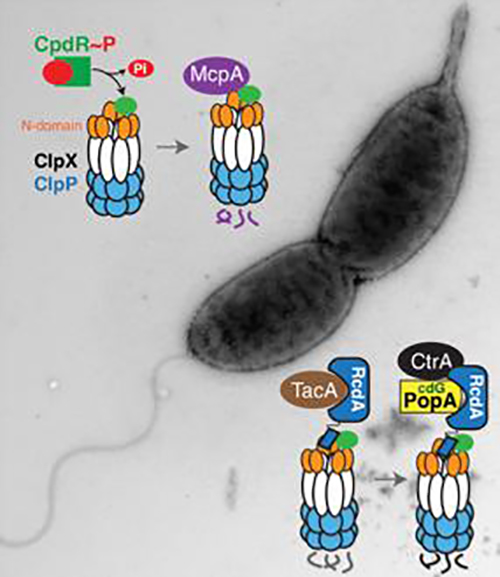![UMass Amherst molecular biologists say newly idientified regulatory adaptors work in a step-wise, hierarchical way to degrade a handful of proteins. Then they recruit an additional adaptor to deliver a different set of proteins to bind even more adaptors. This may offer a new target for developing new antibiotics with a high potential to avoid triggering drug resistance. [UMass Amherst]](https://genengnews.com/wp-content/uploads/2018/08/100827_web1521382532-1.jpg)
UMass Amherst molecular biologists say newly idientified regulatory adaptors work in a step-wise, hierarchical way to degrade a handful of proteins. Then they recruit an additional adaptor to deliver a different set of proteins to bind even more adaptors. This may offer a new target for developing new antibiotics with a high potential to avoid triggering drug resistance. [UMass Amherst]
The importance of protein breakdown, clean-up, and removal during the cell cycle cannot be underscored enough as a major cell regulatory mechanism for multiple metabolic pathways. Researchers have intently studied this cellular maintenance process, called proteolysis, where specialized proteases degrade damaged or no-longer-needed proteins—a pathway where many of the molecular mechanisms still elude scientists.
Now, researchers at the University of Massachusetts Amherst believe they have discovered how an essential bacterial protease controls cell growth and division within the model bacterial species Caulobacter crescentus. The investigators found that growth and replication of this microbe was regulated by a highly conserved protease named ClpXP. In many bacteria this enzyme allows the microbes to deal with stressful environments like the human body, so a greater understanding of ClpXP regulation could lead to new classes of antibacterial therapeutics.
“The odd thing is that ClpXP is always present during different growth stages, but only destroys its target proteins at a specific time,” explained senior author Peter Chien, Ph.D., assistant professor in the department of biochemistry and molecular biology at UMass Amherst. “There must be a missing factor that we couldn't see because something has to come on the scene to accomplish this. There was some genetic evidence pointing to certain additional proteins, but we didn't know how they worked.”
The findings from this study were published recently in Cell through an article entitled “An Adaptor Hierarchy Regulates Proteolysis during a Bacterial Cell Cycle.”
Taking a classical biochemical approach to the problem, Dr. Chien’s team purified all the available proteins along the proteolytic pathway in order to reconstitute the mechanisms in vitro—observing how the interacted and what functions were affected by their presence or absence.
Dr. Chien remarked that his graduate student and lead author Kamal Joshi “found that the ClpXP protease could not by itself destroy the target proteins. Instead, he found that the additional regulatory proteins we had detected were controlling different parts of the process.”
Moreover, the researchers found that the regulatory adapters they identified worked in a step-wise hierarchical way. The first adaptor was directly responsible for degrading a handful of proteins, but it could also recruit an additional adaptor that would deliver a different set of proteins and bind even more adaptors.
Dr. Chien believes that the fundamental knowledge they learned from their current study may offer new targets for developing antibiotics with a high potential to avoid triggering drug resistance mechanisms.
“In this approach, you don't force the benign bacteria to develop resistance because their growth isn't threatened,” Dr. Chien noted. “The hope is to target only those pathogenic organisms that are trying to overcome the stressful environment inside the human body.”
Dr. Chien’s team intend on taking the next steps to determine how many of the adaptor factors are common among all bacteria and if they behave in a similar fashion.
“How proteases selectively destroy their targets is a universal problem,” stated Dr. Chien. “We think that these same mechanisms also may be found in other bacteria, but won't know until we start testing them.”



